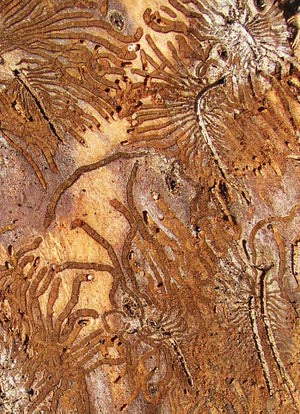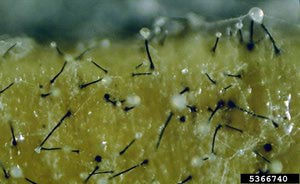Bark Beetles and Symbiotic Fungi: Difference between revisions
No edit summary |
No edit summary |
||
| Line 65: | Line 65: | ||
===Grosmannia Fungi=== | ===Grosmannia Fungi=== | ||
This pathogenic fungi genus is responsible for the destruction by mountain pine beetles. | This pathogenic fungi genus is responsible for the destruction by mountain pine beetles. | ||
====<i>Grosmannia clavigera==== | ====<i>Grosmannia clavigera</i>==== | ||
This fungal species affects Lodgepole pine, Ponderosa pine, Douglas-fir, and Whitebark pine trees. | This fungal species affects Lodgepole pine, Ponderosa pine, Douglas-fir, and Whitebark pine trees. | ||
Revision as of 04:53, 6 April 2012
Introduction
A symbiotic relationship is held between bark beetles and fungi. This interaction has been known to be devastating to forest stands all over the world. Fungi in this interaction lead to the devastating effects in certain arboreal species. There have been many important studies and research performed in order to understand and perhaps to prevent or contain the spread of certain diseases to valued tree stands.
Biological Interaction
Mutualism
Mutualism occurs between two organisms when they both mutually benefit from interacting with one another. Bark beetles transport the fungi to new trees and the symbiotic fungi protect the beetles by preventing the tree from decimating the bark beetles.
Commensalism
Commensalism is an ecological term in which a specific interaction between two organisms allows one organism to benefit while the other organism remains unaffected #1 SOURCE. This interaction between bark beetles and symbiotic fungi is a specific interaction where the bark beetles are unaffected when they carry and spread the fungi through the host tree.
Microbial populations
The interaction between bark beetles and symbiotic fungi not only affect the host plant they are occupying but also microbial populations. When the bark beetles burrow and reside in the host tree they are increasing surface area where other microbes, pathogens, and insects can have a deleterious effect. The interaction between bark beetles and symbiotic fungi is a positive influence. Furthermore, allowing other organisms access to the inside of the tree is a positive influence.
Ecological effects
This interaction between the bark beetles and the symbiotic fungi eventually leads to the death of the tree, then the beetles and fungi move on to their next host. There are ecological consequences to an unregulated population of bark beetles and their symbiotic fungi. Ecologically the continued destruction of types of species of trees can affect the surrounding habitats in that there is less water uptake by a diseased tree, when a tree perishes then it provides an available food source for bacteria and fungi in the environment. This cycle aids in the development of younger trees that are then allowed to grow and take the place of the affected trees.
Niche
Bark beetles have been creating mazes in trees for a long while. These bark beetles live in the dead phloem tissues of trees. Most bark beetles live in dead or decaying trees, however some are known to actively penetrate healthy trees, such as the mountain pine beetle (Dendroctonus ponderosae). Female bark beetles burrow into mature trees, signal males, mate, and then deposit their eggs deep within the tree’s tissue. When bark beetles attack trees that are healthy, these trees may produce resin or latex as a defense.
Elm Trees
In Elm trees, bark beetles spread the fungi through sexual contact. With this, the fungus spreads and due to a tylotic response in the xylem, the tree prevents the fungus from spreading. This response, however, also blocks water from moving up and photosynthates from moving down the trunk of the tree. This Dutch Elm Disease has been spreading across North America killing unresistant elm species.
Pine Trees
In pine trees, bark beetles infest by laying eggs under the bark. Once present in the tree, these beetles inoculate the tree with a blue stain fungus. This specific fungus is injected into the sapwood. This action prevents the tree from controlling or exterminating the beetle larvae with sap. The introduction of this particular fungus blocks water and nutrient transportation within the xylem and phloem of the tree.
Microbial processes
The fungi in these interactions are relied upon by some bark beetles. The blue stain fungus and also the fungi related to Dutch Elm Disease all can prevent the tree's xylem and phloem from functioning properly. The response from the tree eventually will kill the it.
Ecosystem-level Effects
Millions of trees perish each year due to this symbiotic relationship between these two organisms.
Environmental Effects
This microbial process can cause an environmental effect because of the reduction of susceptible species of trees. Having decreasing amounts of trees reduces the amount of carbon sequestering that trees do each year.
Key Microorganisms
Fungi are the major microorganisms that are involved with this symbiotic interaction.
Ophiostomatales Fungi
This fungi genus of pathogens is responsible for the Dutch Elm Disease.
Ophiostoma novo-ulmi
This fungi species is extremely destructive and it was first described in both Europe and North America in the 1940s and has devastated elm stands in both areas since the late 1960s.
Ophiostoma himal-ulmi
This fungal species is very devastating to elms located in the western Himalaya
Ophiostoma ulmi
This fungal species affected elm stands in Europe around 1910 and was transported to North America in 1928
Grosmannia Fungi
This pathogenic fungi genus is responsible for the destruction by mountain pine beetles.
Grosmannia clavigera
This fungal species affects Lodgepole pine, Ponderosa pine, Douglas-fir, and Whitebark pine trees.
Current Research
Institut National de la Recherche Agronomique. Lutèce, a resistant variety, brings elms back to Paris [7], Paris, France
References
Edited by Kord Nolte, a student of Angela Kent at the University of Illinois at Urbana-Champaign.


